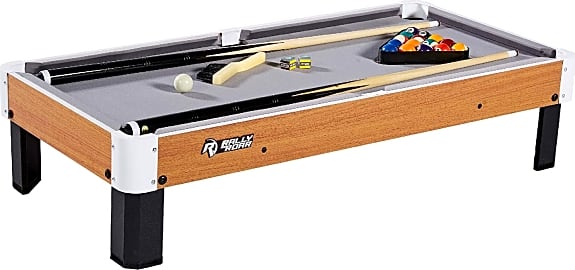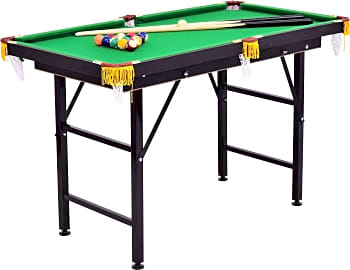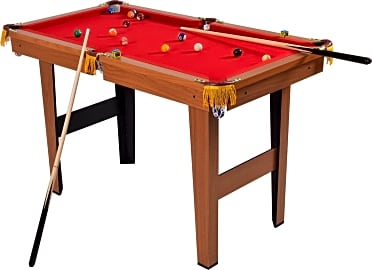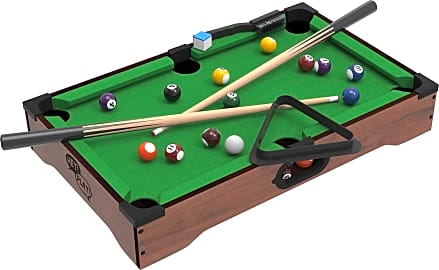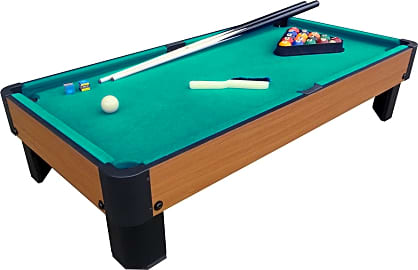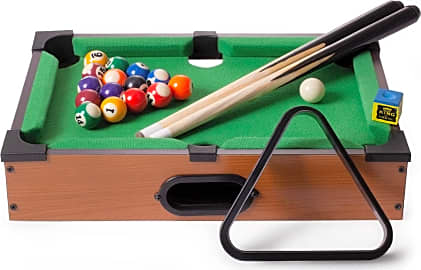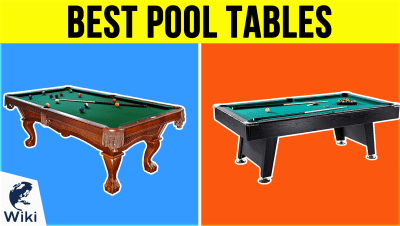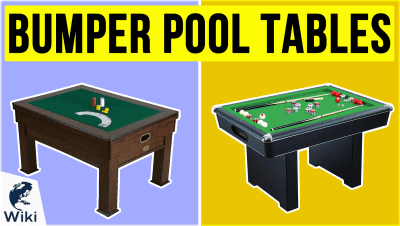The 10 Best Mini Pool Tables

This wiki has been updated 45 times since it was first published in December of 2015. If you love the game of pool, but your home can't accommodate a full-size table, one of these mini models could be the recreational billiards solution you need. Some are small enough to place on a coffee table while others stand on their own legs. They are an affordable way to hone your skills or allow your children to have some fun in the house away from their omnipresent screens. When users buy our independently chosen editorial picks, we may earn commissions to help fund the Wiki.
Editor's Notes
April 22, 2021:
In this update, we noticed that the list was lacking any options that feature multiple games. Since people in the market for a mini pool table probably enjoy playing games and are looking to save space, we decided to include two multi-use options. The Best Choice Arcade Set is a fairly affordable model that sits low to the ground. The MD Sports 4-In-1 is more expensive, but also features longer legs that make it easier to play on its own without having to sit on the floor. While taller adults might have to bend over a bit, it's a good height for kids. Both of these options feature ping pong, foosball, and air hockey in addition to pool (though neither one has blowing air for the hockey).
Also new to the list, the Brybelly Mini is a very tiny version that makes a good desktop accessory (it can also fit in a drawer if you don't want the boss to catch you playing with it on-the-clock). It can be used to play a real game, but the balls are pretty big compared to the table, which can make it a bit tricky to master.
The Big Time Pivot is a unique option that uses a spring-loaded launcher instead of cue sticks. This can be a good choice for people who can only use one hand or for younger kids who don't have the motor skills for regular billiards yet.
We removed the Ideal Rack 'Em due to availability issues.
December 31, 2019:
We ran into a few availability issues with a number of models, like the Sunnydaze 36 and the Harvil Tapbletop. In the case of the former, it seems the company has shifted focus somewhat toward more outdoor furniture and leisure products, and away from games like these. In seeking out replacements for these models, we discovered some excellent options, including the Rack Crux Billiard, which is the largest model we could find that still fit the miniature designation, thanks in large part to the fact that it folds up so easily. Its balls and cues are also larger and heavier than you'll see throughout the rest of the list.
For the most part, we kept an eye on things like size, weight, and build quality, with a bit of a preference for bigger tables that have the ability to break down for storage. This is because, having played on so many of these, we're well aware of the frustrations that too small a table can impart on an adult, which led us to favor models that offered an enjoyable game for grownups and a challenge (though not an unplayable one) for kids. Beyond that, we looked to the quality and number of accessories like cues, chalks, and other materials to help determine our ranking.
Miniature Pool Table; Maximum Fun
These truly miniature versions usually measure little more than a foot and half on the longer sides and can be treated as much as decorations as play objects.
Cue sports — the name given broadly to games involving play with balls, sticks, and tables — have been enjoyed for centuries. There are mentions of billiards found in writings about 15th century French royal courts, in the plays of William Shakespeare, and in many other historical sources, a few of which date back as far as the 1300s. By the mid-1800s, a game quite similar to modern pool had emerged and, by the dawn of the 20th century, its standardization was underway.
Most pool tables used in regulated competition measure either nine feet by 4.5 feet or eight feet by 4 feet. They feature six pockets, and the balls used in play are 2.25-inches in diameter. If you want to play (or practice) pool on a table that will be recognized by the World Pool-Billiard Association, then you will have to do so using one of these sizes of table. However, not only are full-sized pool tables expensive, but they are also often prohibitively large. A 9-foot by 4.5-foot table, for example, necessitates free floor space measuring, at minimum, 16.5 feet by 12.5 feet, which is a larger area than many rooms in many homes.
Fortunately, there is no reason not to enjoy hours of recreational fun on a much smaller table. Many miniature pool tables offer affordable and convenient recreation that employs the same mechanics and rules applying to a full-sized game of billiards, albeit on a smaller scale.
If you are considering a mini pool table for your home or to be given as a gift, first decide whether the table is more for novelty and occasional fun or if you want a table that does indeed function like its full-sized counterparts. A small pool table with the same attributes as a regulation unit — from cup shape to felted surface and rail response — may cost a bit of money, but many are well-made enough to last for years of regular use. Consider a table that measures between five and six feet at least along its longer axis to get a verisimilitude of official pool play, and also look for a table with a bed height of approximately 30 inches above the ground. (Regulation tables must be between 29.25 and 31 inches tall.)
If you are more interested in playfully passing time, consider a tabletop pool table. These squat units stand only a few inches in height, as they are designed to be perched atop a table, desk, or counter. Most such options still measure a few feet on a side and thus allow for challenging shots and plenty of fun, but few approximate genuine pool play given their dimensions.
Finally, there are even smaller pool "tables" that are essentially toys, though are still suitable for momentary diversion. These truly miniature versions usually measure little more than a foot and half on the longer sides and can be treated as much as decorations as play objects.
The Basic Rules of 8-Ball Pool
Just because you don't own a full-sized pool table doesn't mean you can't play a "real" game of pool; after all, so long as all the players involved in a match are using the same equipment, then the playing field is level, as it were, and you might as well take the challenge seriously. To do that, you must know the rules of the world's most popular pool game: 8-Ball.
Pocketing of an opponent's ball is considered as a missed shot.
The game starts with all the balls racked at one end of the table, with the 8-ball in the center of the triangle. The cue ball is fired at the racked balls from the far side of the table. The break shot must either pocket a ball or send at least four balls into contact with rails. If one number ball is pocketed, the player then assumes its cohort — stripes or solids, e.g. If one stripe and one solid (or more of either) are pocketed, the player may choose. Sinking the 8-ball on the break wins the game; sinking the cue ball while breaking results in loss.
Game play then involves each player subsequently trying to sink his or her respective balls while avoiding driving the 8-ball into a pocket. Sinking the 8-ball prior to the pocketing of all of a player's other balls results in a loss. Players continue taking shots after each successful sinking of a ball, and switch turns after a missed shot. Pocketing of an opponent's ball is considered as a missed shot. All non-obvious shots should be called.
If a shot is taken in which the cue ball is pocketed, driven off the table, or fails to touch another ball and at least three rails, it is a scratch. The opposing player may then position the cue ball as desired in the third of the table from which the break shot was taken.
When all of one player's balls (all stripes or solids) have been legally pocketed, that player then commences trying to sink the 8-ball. Doing so wins the game; a scratch while shooting for the 8-ball results in a loss.
Mastering A Trick Shot — No Large Table Required
If you are only going to learn one pool "trick," let it be the masse shot. Pronounced mah-SAY, this "shot" simply refers to putting "spin" on the cue ball, driving it along a curved line as opposed to in a straight line.
To successfully complete a masse shot, you must hold the cue at a much steeper angle than would normally be used with straight shots.
To successfully complete a masse shot, you must hold the cue at a much steeper angle than would normally be used with straight shots. By driving the cue down into the ball, you force it to effectively pop out from between the tip of the cue and the table, which creates spin when properly executed.
The ball will still be driven forward in the general direction as established by the vector of the cue; the degree of spin is established both by the up/down angle of the cue and by where you strike the cue ball. The closer the cue tip strikes the center mass of the ball, the less spin will be created, and vice-versa.
Practicing masse shots (often though slightly inaccurately also called "putting English on the ball") does not require a full-sized pool table at all; it merely requires full sized billiards balls, a good cue, and lots of patience.


